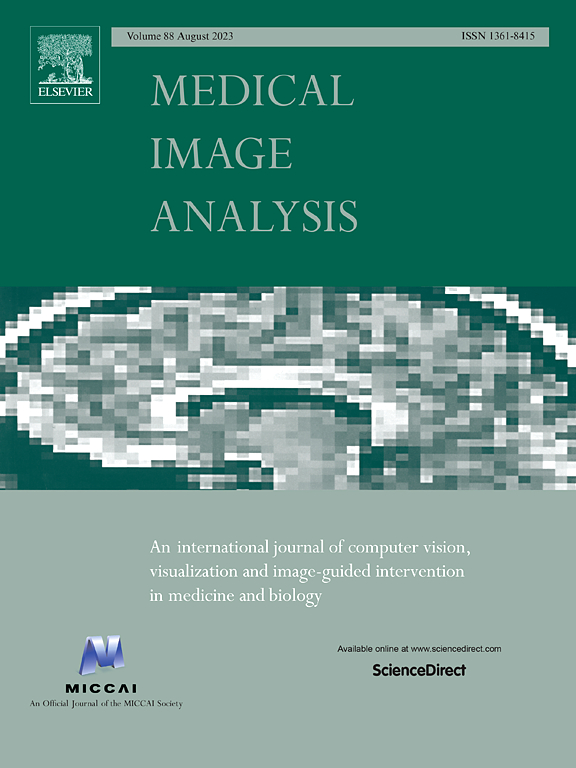FPM-R2Net:融合光声和操作显微成像与交叉模态表示和配准网络
IF 10.7
1区 医学
Q1 COMPUTER SCIENCE, ARTIFICIAL INTELLIGENCE
引用次数: 0
摘要
机器人辅助显微手术在包括神经外科在内的许多临床专业中是一种很有前途的技术。这种手术的先决条件之一是精确的视觉引导,不仅描绘出暴露的表面细节,而且描绘出嵌入的微血管。用于血管成像的传统显微相机容易受到镜面反射和低组织分辨率和对比度的环境光变化的影响。光声显微镜(PAM)由于其高图像分辨率和高组织对比度的优点,越来越多地用于血管成像。本文提出了一种融合显微成像方案,该方案将标准外科显微镜与PAM相结合,以改善术中可视化和指导。我们提出FPM-R2Net通过跨模态表示和配准网络融合光声和外科显微成像。使用模态表示网络(MORNet)提取白光和PAM模态之间的统一特征表示,使用分层迭代配准网络(HIRNet)基于多分辨率特征图以粗到精的方式建立两模态之间的对应关系。使用一个具有真实对应的合成数据集和一个小鼠脑血管系统的体内数据集来评估我们提出的网络。在两个数据集上进行的广泛验证表明,与目前最先进的交叉联合和Dice分数评估方法相比,这两个数据集有了显著的改进(在合成数据集上分别为10.3%和6.6%,在体内数据集上分别为15.9%和11.8%)。本文章由计算机程序翻译,如有差异,请以英文原文为准。
FPM-R2Net: Fused Photoacoustic and operating Microscopic imaging with cross-modality Representation and Registration Network
Robot-assisted microsurgery is a promising technique for a number of clinical specialties including neurosurgery. One of the prerequisites of such procedures is accurate vision guidance, delineating not only the exposed surface details but also embedded microvasculature. Conventional microscopic cameras used for vascular imaging are susceptible to specular reflections and changes in ambient light with low tissue resolution and contrast. Photoacoustic microscopy (PAM) is emerging as a promising tool and increasingly used for vascular imaging due to its high image resolution and tissue contrast. This paper presents a fused microscopic imaging scheme that integrates standard surgical microscopy with PAM for improved intraoperative visualization and guidance. We propose the FPM-RNet to Fuse Photoacoustic and surgical Microscopic imaging via cross-modality Representation and Registration Network. A MOdality Representation Network (MORNet) is used to extract unified feature representation across white-light and PAM modalities, and a Hierarchical Iterative Registration Network (HIRNet) is used to establish the correspondence between the two modalities in a coarse-to-fine manner based on multi-resolution feature maps. A synthetic dataset with ground truth correspondence and an in vivo dataset of mouse brain vasculature are used to evaluate our proposed network. Extensive validation on the two datasets has shown significant improvements compared to the current state-of-the-art methods assessed with intersection over union and Dice scores (10.3% and 6.6% on the synthetic dataset and 15.9% and 11.8% on the in vivo dataset, respectively).
求助全文
通过发布文献求助,成功后即可免费获取论文全文。
去求助
来源期刊

Medical image analysis
工程技术-工程:生物医学
CiteScore
22.10
自引率
6.40%
发文量
309
审稿时长
6.6 months
期刊介绍:
Medical Image Analysis serves as a platform for sharing new research findings in the realm of medical and biological image analysis, with a focus on applications of computer vision, virtual reality, and robotics to biomedical imaging challenges. The journal prioritizes the publication of high-quality, original papers contributing to the fundamental science of processing, analyzing, and utilizing medical and biological images. It welcomes approaches utilizing biomedical image datasets across all spatial scales, from molecular/cellular imaging to tissue/organ imaging.
 求助内容:
求助内容: 应助结果提醒方式:
应助结果提醒方式:


